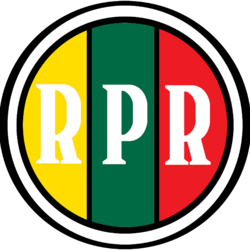Rally for the Republic (Marirana)
Rally for the Republic Raggruppamento per la Repubblica | |
|---|---|
 | |
| Abbreviation | RPR |
| Historical leader | Antonio Michelozzi Niccolò Pellegrini Romano Emanuele Orlando |
| Founded | 7 October 1939 |
| Dissolved | 24 May 1963 |
| Headquarters | Aquinas |
| Ideology | Reformism Left-wing populism Left-wing nationalism Agrarian socialism |
| Political position | Centre-left to left-wing |
| Colours | Red |
The Rally for the Republic (Vespasian: Raggruppamento per la Repubblica) was a left-wing political party that existed throughout the Sixth Republic of Marirana as one of the two main parties alongside the Mariranan Radical Liberal Party (PLRM) until its dissolution following the 1963 military coup.
The RPR was founded after the Great War by reformist politicians, liberal democrats and labour leaders. Its leader was Antonio Michelozzi, a populist who supported social reform and democratisation. In the first post-war election the RPR won under Michelozzi where they implemented import-substantiation industrialisation policies, the expansion of welfare and education and anti-clericalism. The party gained its support from the rural poor and trade unions thanks to its support for land reform (albeit of a moderate variety) and pro-labour legislation. However Michelozzi was criticised for the continued support for the suppression of the Lanzastra movement which demand more radical land reform which alienated the party from some sections of the left.
Near the end of Michelozzi's term the RPR alongside the PLRM formulated the Pact of Democracy to prevent majoritarian rule - whichever candidate won the presidential election would appoint the runner-up as vice-president in a coalition government to stabilise democracy. As such despite PLRM candidate Emilio Štromajer winning the 1946 election the RPR were able to exercise a significant amount of influence over the government during this period, with RPR members being in the office of vice-president.
The RPR's power was concentrated in rural areas (in contrast to the urban based PAR) and relied on local political machines to maintain its power. It was like the PLRM considered ideologically moderate, being representative of reformist policies rather than a coherent political ideology.
In 1952 the party's candidate, former revolutionary general Niccolò Pellegrini, became president. Pellegrini was more left-wing then Michelozzi and implemented progressive measures such as granting women the right to vote, classing indigenous people as citizens and furthering nationalisation of industry. Pellegrini attempted to pass a radical land reform bill in 1955 but was assassinated by a far-right activist with PRM vice-president Paolo Di Quintino serving the rest of his six-year term.
Pellegrini's protege and fellow leftist Romano Emanuele Orlando was elected president in 1958. Orlando continued the reformist agenda nationalising all foreign mines, promoting greater state investment and expansion of welfare. These measures led to institutional pushback from the country's oligarchs in the right-wing of the RPR and the PLRM, leading to Orlando to attempt to change the constitution to enable presidential re-election and further the land reform process. These actions led to the 1963 military coup d'état that ousted Orlando. The RPR was subsequently dissolved with most of its members being imprisoned on the account of being deemed socialists and communists.
When the party was founded in 1939 it emphasised populist, nationalist and democratic views. Over time it became more recognisably left-wing promoting a form of agrarian socialism